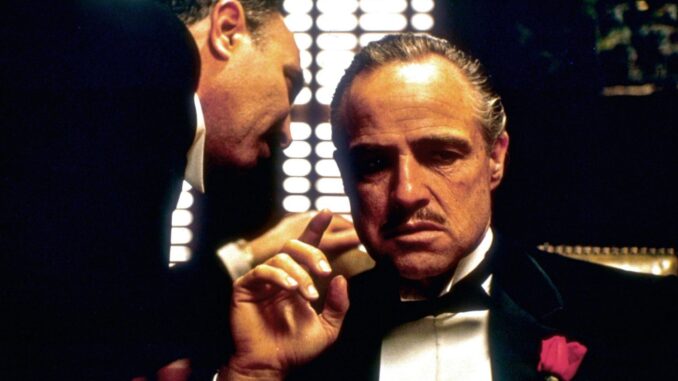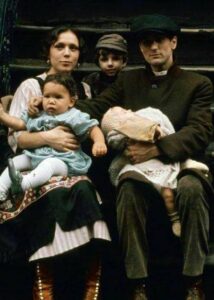
Why The Godfather: Part II is Better than Part I

The Godfather: Part II, directed by Francis Ford Coppola, is considered one of the greatest films ever made. In this video I’ll also argue why it’s better than The Godfather, in almost every respect:
I grade a film on four criteria. These are Technical artistry. Storytelling artistry. Entertainment and Art. A film must ace all four to be great. If you want to know what makes a great film check this out:
Technical artistry
The Godfather: Part II pushed the cinematography style that Gordon Willis made famous – of deep dark shadows – of the warm patina that represents historical flashbacks – and of top lighting.
All this was clearly evident in the original The Godfather, but in the first film, Willis did make a few mistakes. You have to remember the budget was tight and the director, Francis Ford Coppola, was close to being fired a few times. It was a stressful shoot to say the least, and it reflected in some of the decisions the filmmakers had to make.
Thankfully, they made mostly good decisions, otherwise Part II would have never had the chance to get made.
Gordon Willis used top lighting to mostly hide the eyes of the mafia, especially Marlon Brando’s, to make him more mysterious and sinister, even when he’s talking politely.
He also underexposed just enough to get his mood, and he was famous for precisely exposing for the negative so nobody could touch it later. If you want to know more about the brilliant cinematography of Gordon Willis, please check out the video I made. It’s available to members of Wolfcrow Lifetime Access:
In the first film, Gordon goes a little too dark sometimes, but in the second film, you can clearly see he found the perfect balance to his method. Practice helps.
The use of the orange patina is also especially instructive. Whereas in the first film the entire film had a patina, The Godfather: Part II has two eras side by side. The parts of Don Corleone’s early history look richer and dare I say, more gorgeous, than the first film. Again, as a filmmaker, if you want to learn how to get the technical aspects of cinematography right, you’re better off studying Part II, though you should watch both.
The technical artistry extends into the production design as well, which had to contend with creating two worlds a generation apart.
Storytelling artistry
Then we come to editing. Editing is one area The Godfather: Part II clearly outdoes the first film. Coppola had the hard task of weaving between scenes of the old and the new, and I see it as one of the great jobs of editing ever in cinema. The choices he had were tremendous, almost putting it on par to a documentary.
I’ve heard an interview where he says he was still not happy with the final edit, because they were too close to release, and he wished he had a couple more weeks at it. He never did a director’s cut, so I guess he must be content, because it’s utter perfection how the story unfolds between both worlds, with clear parallels, and you can follow everything without being aware of the fact.
The Godfather was a novel, and I had the misfortune of having read the novel before having watched the film. A lot of the novel is left out in the film, and I believe rightly so. The film Coppola wanted to make wouldn’t have turned out the same way with those extra scenes.
Marlon Brando’s idea of creating the Godfather was sheer genius, but never quite matched up to the novel, or my imagination of it, anyway. In Part II though, half the movie is from the original book, as it traces the beginning of Don Corleone, and this was more interesting as a character study, and how the choices Vito Corleone took as a young adult affected the choices his son Michael had to make in his quest.
As far as storytelling choices go, The Godfather had it easy, because most of the characters who die were killed off by the enemy. In Part II, you have deceptions and the curse of family trying to stab you in your back. It also has the unenviable task of making a hard to love Michael Corleone sympathetic. At the end you’re twisted in your feelings for him, and that’s a miracle considering the clear enormity of his crimes.
Part II also highlighted the reality of being a Godfather, in stark contrast to the romanticism of being one in the early era. It was all roses, but that was an illusion. Everything falls apart for Michael and the Corleone family, and it falls because of family.
That’s an order of magnitude harder to pull off as a storyteller than the classical plot of The Godfather. If you’re studying cinema, actors, editing and storytelling, both Parts I and II should be a priority, and The Godfather: Part II, you should double down on.
Entertainment
Both films are equally entertaining. The first film had many Game of Thrones-level shocks, and you wanted to see the rise of Michael a la the hero’s journey.
In Part II, Coppola couldn’t repeat the formula, so he had to involve a twisted tale where it was hard to figure out who your friends were and who your enemies were. And it still manages to be entertaining. Maybe not as much as the first film, because the first film speaks to the lowest common denominator, whereas the second film is more real.
Both films are actually like one big story in two parts, so there’s no watching one without the other. And you can rewatch both films again and again, which cements its legacy as real entertainers.
Art
Is the Godfather Parts I and II art? Yes it is, because Coppola created a world that most non-Italians weren’t aware of, and he invited us into that world and it looked all too real and true. After about fifty years, looking back, you can clearly see how both films have aged like a great painting that you just can’t get enough of.
Comparing both though, The Godfather was straight from the novel, and though it was executed to near perfection it wouldn’t hold a candle to Part II, because Part II showed the mastery of Coppola the filmmaker, which is important in art. The stamp of the artist is paramount.
In the first film he was bound by the story and budget, in the second film he could fly, and tell his own story married to the original. In every aspect of filmmaking – technical or artistic, Part II is clearly the film to study for serious film students.
Because that’s how you marry art and entertainment and make the near perfect film, which is why The Godfather: Part II is eighth on my list of 100 films to see before you die:
